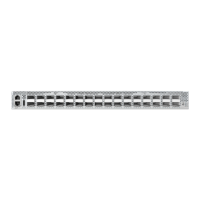C
HAPTER
13
| Security Measures
Access Control Lists
– 294 –
◆ Destination Prefix-Length – A decimal value indicating how many
contiguous bits (from the left) of the address comprise the prefix; i.e.,
the network portion of the address. (Range: 0-64 bits)
◆ DSCP – DSCP traffic class. (Range: 0-63)
◆ Next Header – Identifies the type of header immediately following the
IPv6 header. (Range: 0-255)
Optional internet-layer information is encoded in separate headers that
may be placed between the IPv6 header and the upper-layer header in
a packet. There are a small number of such extension headers, each
identified by a distinct Next Header value. IPv6 supports the values
defined for the IPv4 Protocol field in RFC 1700, and includes these
commonly used headers:
0 : Hop-by-Hop Options (RFC 2460)
6 : TCP Upper-layer Header (RFC 1700)
17 : UDP Upper-layer Header (RFC 1700)
43 : Routing (RFC 2460)
44 : Fragment (RFC 2460)
50 : Encapsulating Security Payload (RFC 2406)
51 : Authentication (RFC 2402)
60 : Destination Options (RFC 2460)
◆ Flow Label – A label for packets belonging to a particular traffic “flow”
for which the sender requests special handling by IPv6 routers, such as
non-default quality of service or “real-time” service (see RFC 2460).
(Range: 0-1048575)
A flow label is assigned to a flow by the flow's source node. New flow
labels must be chosen pseudo-randomly and uniformly from the range
1 to FFFFF hexadecimal. The purpose of the random allocation is to
make any set of bits within the Flow Label field suitable for use as a
hash key by routers, for looking up the state associated with the flow.
A flow identifies a sequence of packets sent from a particular source to
a particular (unicast or multicast) destination for which the source
desires special handling by the intervening routers. The nature of that
special handling might be conveyed to the routers by a control protocol,
such as a resource reservation protocol, or by information within the
flow's packets themselves, e.g., in a hop-by-hop option. A flow is
uniquely identified by the combination of a source address and a non-
zero flow label. Packets that do not belong to a flow carry a flow label of
zero.
Hosts or routers that do not support the functions specified by the flow
label must set the field to zero when originating a packet, pass the field
on unchanged when forwarding a packet, and ignore the field when
receiving a packet.

